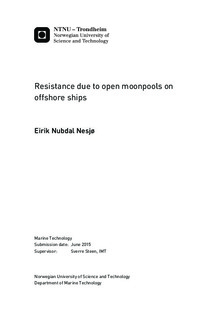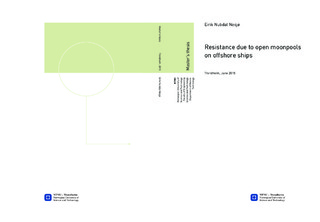| dc.description.abstract | A moonpool is a vertical well in a vessels hull that is exposed to the sea. Many types of offshore
vessels are equipped with such a moonpool, to facilitate maritime operations. The water column
inside of the moonpool is known to oscillate violently, and in model test, these oscillations
have been connected to a resistance component. It is also well known that, during transit, an
open moonpool will increase the resistance of the hull. Even so, most vessels are not equipped
with any measures intended to reduce the added resistance from the moonpool.
This thesis has an objective aimed at building an understanding of the added resistance due
to moonpool on offshore ships. The focus as been on forward velocities in calm waters, with an
overall goal to derive general expressions describing the resistance.
After a thorough literature study, surprisingly few directly related experiments were found. It
was established that the resistance consists primarily of the base resistance as the moonpool
is a modification on the hull. Secondly it has been shown that the amplitude of the vertical
piston-mode oscillation, is directly connected to a second resistance component. Expressions
that estimates the amplitude development, and its connection to the resistance were found.
Numerical simulations were conducted using PVC3D, a software developed by MARINTEK. This
solver is based on a hybrid method that combines the viscous flow with boundary conditions
from potential flow theory.
The simulations were used to confirm the prediction models for the oscillation amplitudes. The
oscillations are only observed within a smaller range of velocities. The expected range can be
expressed by the normalised reduced velocity U => [0.35 -0.60] in calm waters.
In conclusion, it is expected that the total resistance of an offshore vessel increases in the area of
5-10 %, due to the existence of a moonpool. The piston-mode oscillation might contribute with
an additional increase in the magnitude of 20-30 %. However, this is related to the maximum
expected amplitude, which can be expected to be present in velocities well below the service
speeds of offshore vessels. The resistance component related to the amplitude is related to a
high level of uncertainties and should be a topic for further investigations. | |

